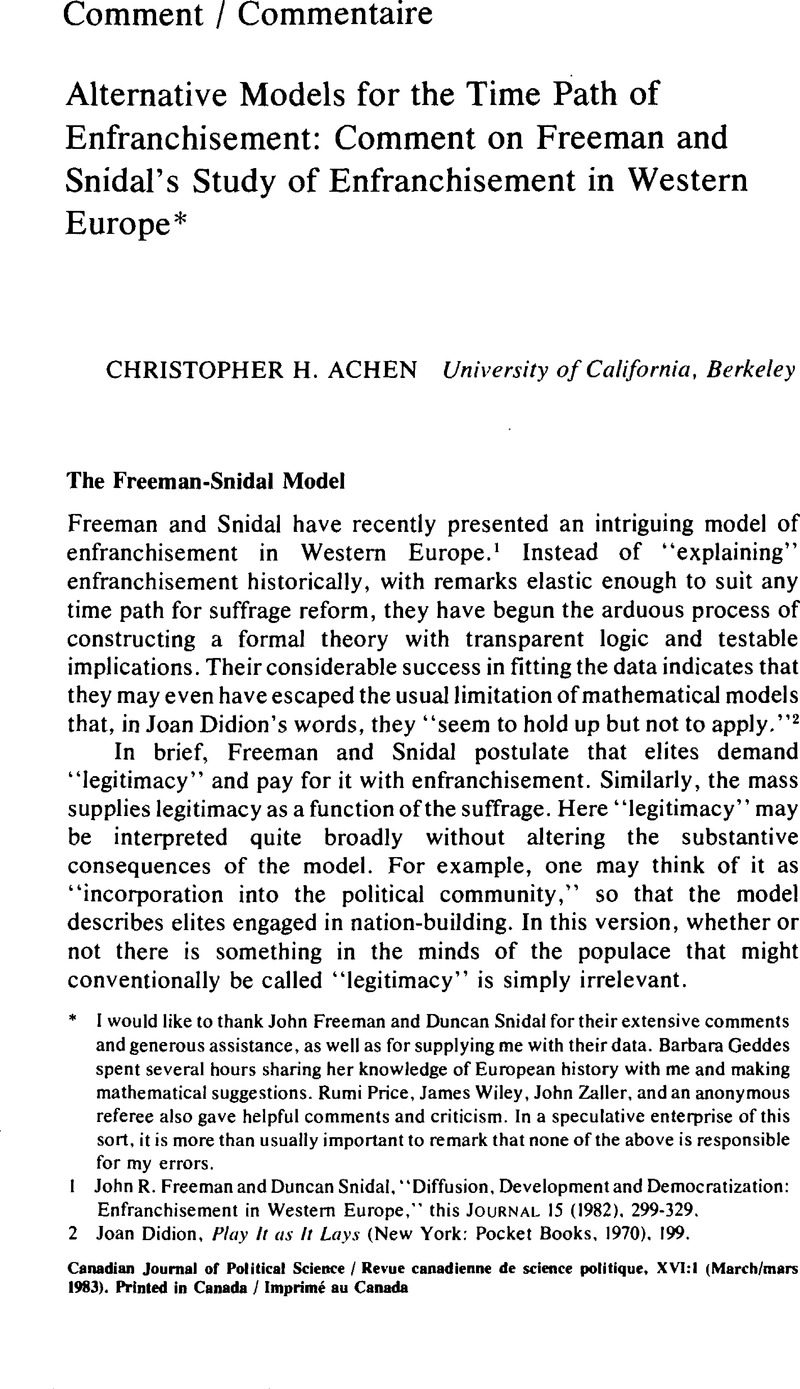No CrossRef data available.
Published online by Cambridge University Press: 10 November 2009

1 Freeman, John R. and Snidal, Duncan, “Diffusion, Development and Democratization: Enfranchisement in Western Europe,” this JOURNAL 15 (1982). 299–329.Google Scholar
2 Didion, Joan, Play It as It Lays (New York: Pocket Books, 1970). 199.Google Scholar
3 Richardson, Lewis F., Arms and Insecurity (Chicago: Quadrangle Books, 1960).Google Scholar
4 After many hours of data analysis, including adjustments for disenfranchisement of women and trials of several alternative functional forms, I have nothing to add to Freeman and Snidal's summary of the data.
5 Niebuhr, Rcinhold, Moral Man and Immoral Society (New York: Scribner's, 1932), 137.Google Scholar
6 An elementary survey is Michael OInick, An Introduction to Mathematical Models in the Social and Life Sciences (Reading, Mass.: Addison-Wesley, 1978), chap. 13.
7 Rogers, Everett M., Diffusion of Innovations (New York: Free Press, 1962). 109.Google Scholar
8 Diffusion theory's ancestry in the study of communicable diseases also explains why it places so much emphasis on communication and so little on the decision to adopt.
9 Those who prefer a rational-choice framework should note that if (a) an elite member regards as acceptable for the franchise those citizens whose benefits to him from enfranchisement exceed their costs, (b) the difference between benefits and costs is linearly proportional to social standing, and (c) the benefit-cost difference declines linearly with time, then equation (5) follows. A special case of this interpretation occurs when projected benefits of enfranchisement are fixed over time, but estimated costs decline steadily as elite fears diminish.
10 More precisely, sufficient conditions are that the factors be statistically independent of each other and have finite means, finite variances uniformly bounded below by a positive number, and third absolute moments uniformly bounded above (see Bartlett, M. S., An Introduction to Stochastic Processes [3rd ed.; Cambridge: Cambridge University Press, 1978], 8–9)Google Scholar. The independence assumption can be weakened.
11 Suppose that the factors generating prestige produce only deviations around parental prestige. Under assumptions like those above, the same normality result holds. Thus the model is perfectly consistent with either fluid intergenerational movement or rigid hierarchy with very little social mobility.
12 Blinder, Alan S., Toward an Economic Theory of Income Distribution (Cambridge. Mass.: MIT Press, 1974), chap. I.Google Scholar
13 In this model, elites compromise over preferred levels of social standing, not directly over preferred levels of enfranchisement. If the latter assumption is made, which is perhaps somewhat more attractive, then the same final result applies if elites all leam at the same rate (though perhaps from different starting positions) and if they have normally distributed preferences for acceptable levels of social standing at time 0. (The mathematical result needed, that the average of cumulative normal distributions with normally-distributed arguments is cumulative normal, appears in, for example, Frederick M. Lord and Melvin R.Novick, Statistical Theories of Mental Test Scores [Reading Mass.: Addison-Wesley, 1968], 376–77.) In the present version, distributional assumptions about elite preferences are avoided.
However, Rogers, in Diffusion of Innovations, offers some evidence that normality assumptions often may be reasonable in modeling susceptibility to adoption of new practices. If so, not only the results of this study, but also the usual S-shaped curve for adoption of discrete innovations would follow in an obvious way from assumptions like those in the preceding paragraph of this footnote-without making the mathematically fecund but socially unrealistic assumptions typical of the diffusion literature.